BY: Ana Cheung, BSN
On Wednesday, May 28th, I attended the nation’s first hospital Mini Maker Faire held at Maimonides Medical Center. I had never heard of a Maker Faire before and was curious to check it out. According to the Maimonides Medical Center website, the goal of the Mini Maker Faire was to “reach out to the community and local organizations to learn and invite makers to participate in the Making Health projects that harness hands-on ingenuity to make patients better and stay health in and out of the clinic.” This event partnered with a larger campaign, the MakerNurse initiative, which seeks to highlight the everyday inventions created by nurses in the field, to study the nurse-making process and to share that knowledge with the health care community.

Maimonides Medical Center’s Poster for their Mini Maker Faire. Image courtesy of Maimonides Medical Center.
During my tour of the Mini Maker Faire, I spoke briefly with Kelly Reilly, RN, the Director of Nursing Research and Evidence-Based Practice at Maimonides Medical Center. Director Reilly was fascinated by New York’s Maker Faire, which happens annually at the New York Hall of Science in Queens, and was interested in bringing a Maker Faire focused on nurse making to Maimonides Medical Center. She was drawn to the idea of a Maker Faire since “nurses are natural makers as they solve problems in real time and test what works or not.” She also noticed “that there are a lot of maker nurses out there as well as makers from other disciplines.” Making, she observed, is a team event, and the Maker Faire itself is an effective means to continue and expand the conversation of making within an organizational level.
Maimonides Medical Center was an early adopter of MakerNurse initiative. Through this partnership, Reilly has incorporated making into Maimonides Medical Center Community of Nurse Scholars (a redesigned Nursing Research Committee) by creating a MakerSpace. This has placed nurse inventiveness and fabrication at the forefront of the scholarship of discovery and ignited a new kind of spirit of inquiry within nursing.
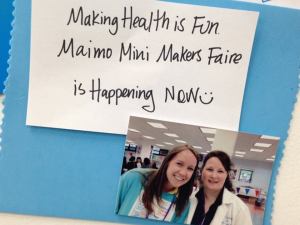
Photo of Director Reilly (right) and Researcher Young (left) at the Maimonides Mini Maker Faire. Image courtesy of Maimonides Medical Center.
The team behind the MakerNurse initiative of the Little Devices Lab at MIT is Jose Gomez-Marquez and Anna Young, medical technology researchers at the Institute. Gomez-Marquez and Young have been spearheading the making movement within the health field the last 6 years at MIT. “We have traveled all over the world and discovered nurses are actively making everywhere,” said Gomez-Marquez. “Medical technology is super expensive but it doesn’t have to be, if we instead utilize health making.” He continued, “For example, look at the ‘DIY Medical Simulation for Ages 10 and under.’ Using Jelly Beans, Tic-Tacs, Hot Tamale candies, Karo Syrup and food coloring, you can simulate leukemia blood at a fraction of the cost of SIM blood while teaching children about the infection process.” It was also one of the best designs he had ever seen for such a system.

Photo of DIY Blood using Jelly Beans, Hot Tamale candies, Karo Syrup and food coloring. Image courtesy of Little Devices at MIT.
Gomez-Marquez wants to ensure patients and caregivers are also included in health making. “The Little Devices Lab wants every hospital to have a maker space and is partnering with hospitals around the country to realize this vision.” The Mini Maker Faire at Maimonides Medical Center was the first of its kind and he hopes there will be more like it moving forward. The Little Devices Lab is already working with several other hospital systems to host medical Mini Maker Faires.

Photo of health care professionals at various exhibit tables. Images courtesy of Little Devices at MIT.
Young emphasized that health making is connecting people to build a stronger network to collaborate and to encourage them to think about their profession in different ways. “Health care and medicine have their challenges and will run into walls. Health making is improving patient care by providing sustainable solutions.” Young comments that health making is not a new phenomenon but something that has been happening for quite some time. “Health making is happening everywhere—we just gave it a name.”
As part of her research, Young follows nurses all over the country, such as Reilly, to see what they are making, then returns to the lab to devise ways to support their efforts. One such apparatus produced by the lab is the technology crash cart, which serves as “one stop shop for creating solutions,” explained Nikolas Albarran, an MIT undergraduate who works with Gomez-Marquez and Young. He added, “MakerNurse encourages nurses to come up with solutions and share them. The more we know, the more we can do to improve patient care.” The cart is filled with materials and tools to help nursing staff brainstorm and create, the stuff of nurse making. Currently, the technology crash cart is housed in Reilly’s office where she often takes it to meetings and delivers it to units at their request. They have assembled a network of hospitals which are currently piloting the carts and returning results in real time back to MIT.
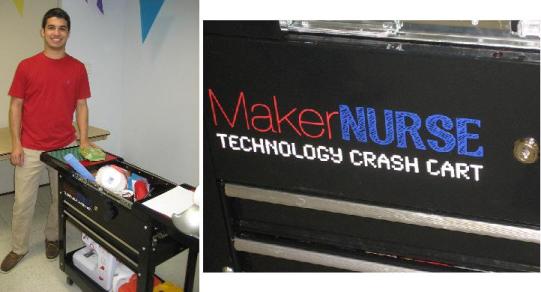
Photo of MIT’s Nikolas Albarran with MakerNurse Technology Crash Cart (l) and MakerNurse Crash Cart Logo (r).
In order to make the Mini Maker Faire happen at Maimonides Medical Center, Reilly reached out to Gomez-Marquez and Young as well as the New York Hall of Science. As an academic partner within the Maker Faire community, the New York Hall of Science has been a leader in the making movement, as it fosters an environment of creativity and experimentation for families through its public MakerSpace. David Wells, the Manager of Creative Making and Learning at NYSCI, learned about the MakerNurse initiative earlier this year when he met Young at the Bangkok Festival. “We are already doing this with kids and families so it makes sense to start doing this within the health care community. Health making will help break down barriers between professions and increase the sharing of knowledge between them.” He pointed out that the collaboration among Gomez-Marquez, Young, and Reilly was a prime example of interprofessional teamwork.
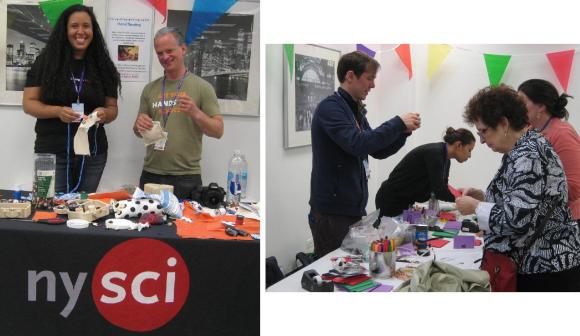
Photo of New York Hall of Science’s David Wells and Janella Watson at the Hand Sewing station (l), and colleagues Reid Bingham and Nancy Portillo at the Paper Circuit station (r).
The first exhibit I visited at the Maimonides Medical Center Mini Maker Faire was the Lego-building and knitting station run by Victor Ty, RN, a radiation oncology nurse at the Cancer Center of Maimonides Medical Center. A machine constructed entirely of Lego caught my eye. Ty explained that the model was a miniature version of a linear accelerator, which provides radiation treatment for pediatric and adult patients. “The Lego model teaches pediatric patients what the machine does and what to anticipate during treatment,” said Ty. “It is equipped with a rotating gantry, on board imaging and a couch or treatment table that goes up and down as well as slides back and forth, which make it a realistic and effective tool for education.” This type of implement is necessary as it helps patients feel more comfortable about the treatment. Ty’s wife, Amie, who is a nurse at NYU Langone Medical Center, also uses the model when teaching pediatric patients about radiation treatment using linear accelerators.
Ty’s inspiration for developing the model arose when he was working with a 17 year old cancer patient who was autistic and nonverbal. He created the model as way for his patient to learn about the machine in a more hands-on manner. According to Ty, “Health care professionals are not trained to deal with patients with autism so health making, such as through this Lego model, can help health care providers connect with patients on a more tangible level.” Ty has much experience working with autistic children as his 15 year old son is also autistic. His son is the motivation for why he became a nurse. His previous career in the fashion world focused on business programming, textile and apparel research & development, as well as supervision of production and logistics.

Photo of Victor Ty with his ten year old son, who also presented at the Maimonides Mini Maker Faire.
At the other side of the table, Ty had an assortment of spools of yarn and knitting looms used by patients and staff. He initially knitted items as a means to fundraise for his autistic son. Ty can be found knitting in the lounge or waiting areas at the cancer center sharing knitting secrets with patients. “I found patients who knit for other patients and I think this is so empowering and incredible for them. I use a loom which is very unorthodox to old-school knitting. The knitting looms are easier to use than needles and maintain tension within the yarn so that when you are knitting the rows always comes out even.” Ty also finds that knitting is beneficial because “it relieves tension for patients and staff and connects nurses on a more creative level.” Ty is currently making baby booties to be donated to the NICU and L&D units as gifts to families who want them.
When asked about the significance of Maimonides Mini Maker Faire, Ty said, “The Mini Maker Faire is important because nurses are ingenious and are always troubleshooting on the floor. We need nurses to share and spread their ideas so that we can be more innovative in caring for our patients.” He points out, that this is especially significant since the US has so many resources at its disposal as opposed to the Philippines, from where he is originally. “Nurses there are always health making due to the scarcity of medical supplies. Imagine what we can do here.”

Photo of Haiku U station (l). Photo of Director Reilly explaining Haiku U station to attendees (r). Image (r) courtesy of Little Devices at MIT.
The Haiku U station was an unexpected surprise as I had assumed making was about inventing things. However, Logan Hegg, PsyD, clarified that “Making is ideas and experiences, not just making things.” The Haiku U station was supplied with bright construction paper, a photo printer, markers and decorations for making the perfect haiku collage. Hegg elaborated that writing haikus is a form of narrative medicine, which helps put words to an experience and is powerful tool for all users. “For kids, Haiku U is an organic process which gives them agency and serves as a normalizing activity. For parents and families, it helps them process illness. For staff, it helps relieve every day stress and tension.”
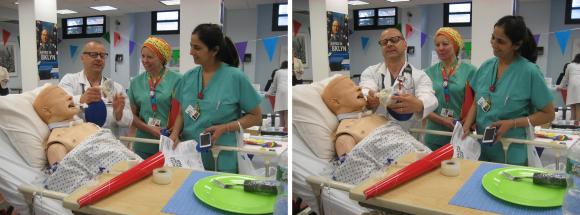
Photo of Gaspare Leo, RRT, demonstrating use of his invention the BVM with non-detachable face mask.
In the middle of the room, I watched Gaspare Leo, a respiratory therapist at Maimonides Medical Center, show nurses the BVM with non-detachable face mask, which he co-invented with his colleague, Roscoe Peace. His invention is a multiple-use airway which he states “can be utilized in combination with or without an artificial airway such as an endotracheal tube or a tracheotomy tube that can be inverted and can be utilized in a normal position and an inverted position that is a single-piece to prevent losing a detachable airway mask.” The mask is bonded to the manual resuscitator so that it cannot be detached from it. This is one of the challenges in using present-day natural resuscitators as the facemask is often missing or misplaced, rendering them useless.
This is exactly what happened to him several years ago when he responded to an emergency call. The mask was missing from the resuscitator and valuable time was lost searching for it, when he could have been ventilating the patient instead. As a result of the incident, he developed the BVM with non-detachable face mask with Peace. He is currently looking for investors for his invention so that it may be used in health care settings, across the country and world-wide.
The Maimonides Medical Center Mini Maker Faire was a truly educational and enjoyable experience. I look forward to future Mini Maker Faires at other hospitals in NYC, as they are a hot bed of ideas and fodder for discussion.
As someone who is a fan of DIY projects, I hope that nursing schools will consider including a nurse making approach in the their curriculum, as it may truly advance the future of health care. One of Wells’ projects at the NYSCI is to oversee the Innovation Institute, which teaches high school students the craft and skills of building. Using this knowledge, students design inventions which respond to an actual community need. Can you imagine how amazing it would be if nursing students had access to making labs and were challenged to develop sustainable solutions to remedy real-life problems in the health care field?
For more information about Nurse Making and the Maker Faire movement, please visit:
Maimonides Mini Maker Faire
MakerNurse
Maker Faire
Make: A Hospital Mini Maker Faire
Little Devices at MIT
Ana Cheung, BSN
Ana Cheung is a May 2014 graduate of NYU’s Accelerated Baccalaureate Nursing Program and is one of the writers for the NYC Men In Nursing blog. She is interested in medical-surgical and community health nursing, as well as working with geriatric and underserved populations. She is a native of Brooklyn and has enjoyed many clinical rotations at Maimonides Medical Center.

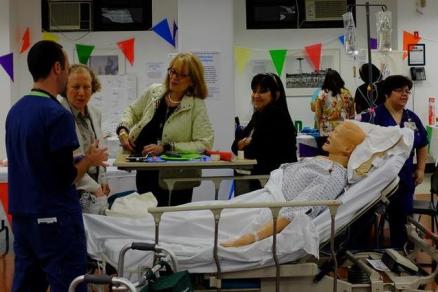
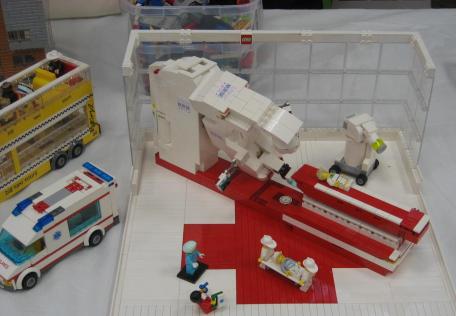

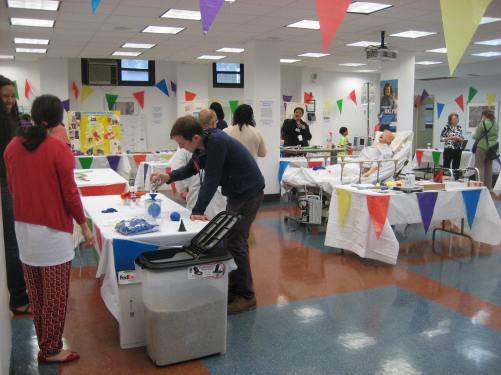

That’s a great article Ana! It highlights the creative side of nurses that is rarely featured, though we do it everyday in our careers. The men in nursing may want to participate in the next Maker Fair.
Hi Fidel! Thank you for your comment. I agree that nurse making is something that has been very much behind the scenes. Hopefully with future mini Maker Faires, it will become more well-known and I agree that it would be great if our group could become more involved in the movement.
[…] the tech-based practice of today’s compassionate nursing. In the last year, Kelly instituted the first Mini Maker Faire at an American hospital, was an early U.S. chapter-adopter of MakerNurse.org initiatives (founded at MIT) at Maimonides and […]